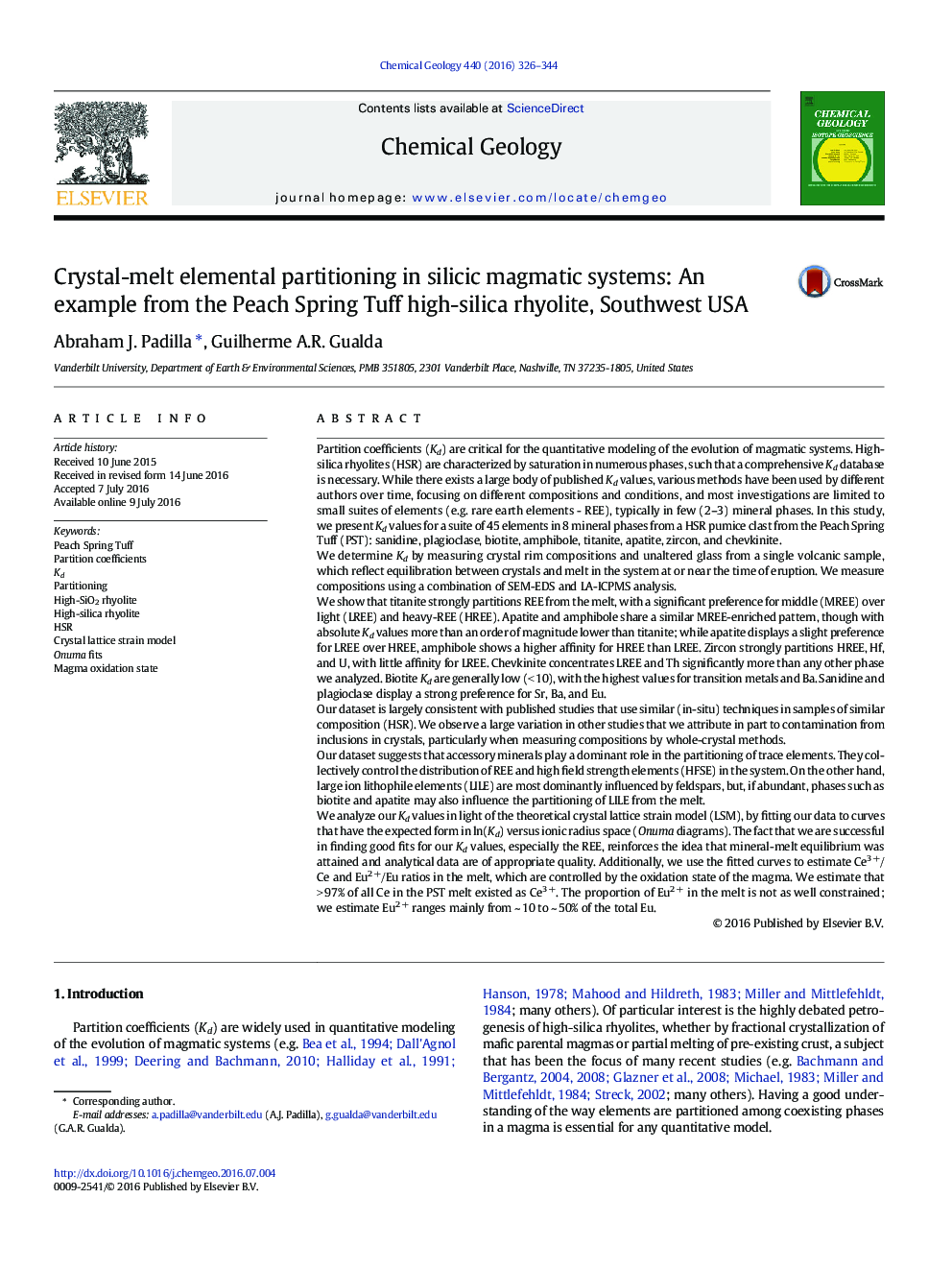| کد مقاله | کد نشریه | سال انتشار | مقاله انگلیسی | نسخه تمام متن |
|---|---|---|---|---|
| 6436051 | 1637534 | 2016 | 19 صفحه PDF | دانلود رایگان |
- A new comprehensive partition coefficient (Kd) dataset for high-SiO2 rhyolite systems
- Kd determined in-situ from natural glass-bearing rocks are most reliable for modeling.
- Fitting of Onuma curves allows first-order test of Kd dataset quality.
- Accessory minerals control REE and HFSE in magma, while feldspars control LILE.
- Onuma fits permit direct estimates of oxidation state via Ce3Â +/CeTot and Eu2Â +/EuTot
Partition coefficients (Kd) are critical for the quantitative modeling of the evolution of magmatic systems. High-silica rhyolites (HSR) are characterized by saturation in numerous phases, such that a comprehensive Kd database is necessary. While there exists a large body of published Kd values, various methods have been used by different authors over time, focusing on different compositions and conditions, and most investigations are limited to small suites of elements (e.g. rare earth elements - REE), typically in few (2-3) mineral phases. In this study, we present Kd values for a suite of 45 elements in 8 mineral phases from a HSR pumice clast from the Peach Spring Tuff (PST): sanidine, plagioclase, biotite, amphibole, titanite, apatite, zircon, and chevkinite.We determine Kd by measuring crystal rim compositions and unaltered glass from a single volcanic sample, which reflect equilibration between crystals and melt in the system at or near the time of eruption. We measure compositions using a combination of SEM-EDS and LA-ICPMS analysis.We show that titanite strongly partitions REE from the melt, with a significant preference for middle (MREE) over light (LREE) and heavy-REE (HREE). Apatite and amphibole share a similar MREE-enriched pattern, though with absolute Kd values more than an order of magnitude lower than titanite; while apatite displays a slight preference for LREE over HREE, amphibole shows a higher affinity for HREE than LREE. Zircon strongly partitions HREE, Hf, and U, with little affinity for LREE. Chevkinite concentrates LREE and Th significantly more than any other phase we analyzed. Biotite Kd are generally low (<Â 10), with the highest values for transition metals and Ba. Sanidine and plagioclase display a strong preference for Sr, Ba, and Eu.Our dataset is largely consistent with published studies that use similar (in-situ) techniques in samples of similar composition (HSR). We observe a large variation in other studies that we attribute in part to contamination from inclusions in crystals, particularly when measuring compositions by whole-crystal methods.Our dataset suggests that accessory minerals play a dominant role in the partitioning of trace elements. They collectively control the distribution of REE and high field strength elements (HFSE) in the system. On the other hand, large ion lithophile elements (LILE) are most dominantly influenced by feldspars, but, if abundant, phases such as biotite and apatite may also influence the partitioning of LILE from the melt.We analyze our Kd values in light of the theoretical crystal lattice strain model (LSM), by fitting our data to curves that have the expected form in ln(Kd) versus ionic radius space (Onuma diagrams). The fact that we are successful in finding good fits for our Kd values, especially the REE, reinforces the idea that mineral-melt equilibrium was attained and analytical data are of appropriate quality. Additionally, we use the fitted curves to estimate Ce3Â +/Ce and Eu2Â +/Eu ratios in the melt, which are controlled by the oxidation state of the magma. We estimate that >Â 97% of all Ce in the PST melt existed as Ce3Â +. The proportion of Eu2Â + in the melt is not as well constrained; we estimate Eu2Â + ranges mainly from ~Â 10 to ~Â 50% of the total Eu.
Journal: Chemical Geology - Volume 440, 15 November 2016, Pages 326-344
